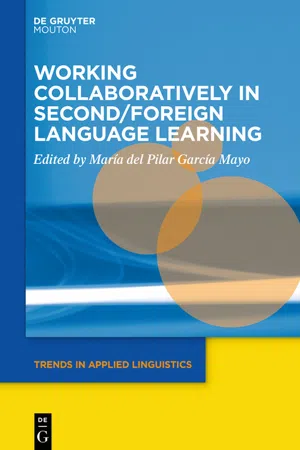
- 237 pages
- English
- ePUB (mobile friendly)
- Available on iOS & Android
Working Collaboratively in Second/Foreign Language Learning
About this book
Since the introduction of communicative language teaching, collaborative learning has played an important role in the second language (L2) classroom. Drawing from sociocultural theory, which states that human cognitive development is a socially situated activity mediated by language, studies in L2 pedagogy advocate the use of tasks that require learners to work together. Collaborative dialogue encourages language learning, and research shows that the solutions reached by students in this process are more often correct with a lasting influence on their language comprehension.
This volume includes ten chapters that illustrate the benefits of collaborative dialogue in second foreign language classrooms. The volume considers key issues dealing with collaborative tasks and implications for language teaching.
Frequently asked questions
- Essential is ideal for learners and professionals who enjoy exploring a wide range of subjects. Access the Essential Library with 800,000+ trusted titles and best-sellers across business, personal growth, and the humanities. Includes unlimited reading time and Standard Read Aloud voice.
- Complete: Perfect for advanced learners and researchers needing full, unrestricted access. Unlock 1.4M+ books across hundreds of subjects, including academic and specialized titles. The Complete Plan also includes advanced features like Premium Read Aloud and Research Assistant.
Please note we cannot support devices running on iOS 13 and Android 7 or earlier. Learn more about using the app.
Information
“Together we do better”: The effect of pair and group work on young EFL learners’ written texts and attitudes
1 Introduction
2 Literature review
Table of contents
- Title Page
- Copyright
- Contents
- Foreword
- Introduction
- Collaborative writing: Promoting languaging among language learners
- The efficacy of collaboratively completing form-focused tasks: A research synthesis
- What exactly is mutuality? An analysis of mixed-age peer interactions on classroom tasks in German secondary school classrooms
- “Together we do better”: The effect of pair and group work on young EFL learners’ written texts and attitudes
- The effect of collaborative writing on individual writing strategies: A case study of two L2 English writers
- Learner interaction in blended collaborative L2 writing activities
- Computer-based collaborative writing with young learners: Effects on text quality
- Online collaboration through tasks for L2 pragmatic development
- Participation and interaction in wiki-based collaborative writing: An Activity Theory perspective
- Factors mediating small-group interactions during synchronous web-based collaborative summary writing using Google Docs
- Index